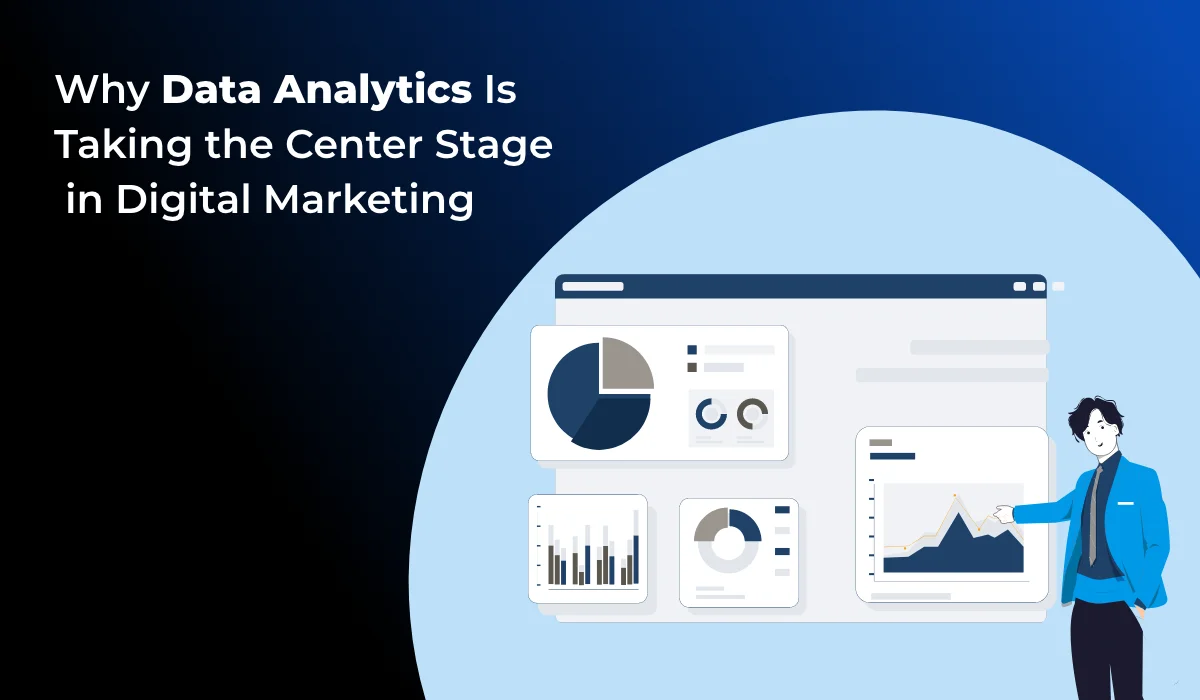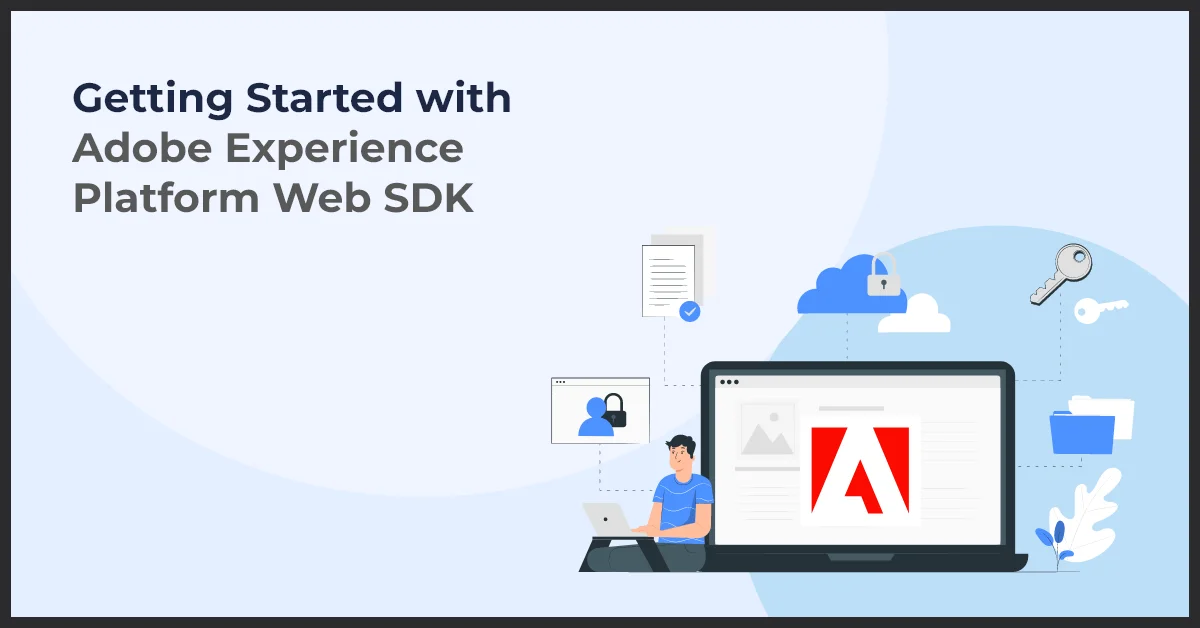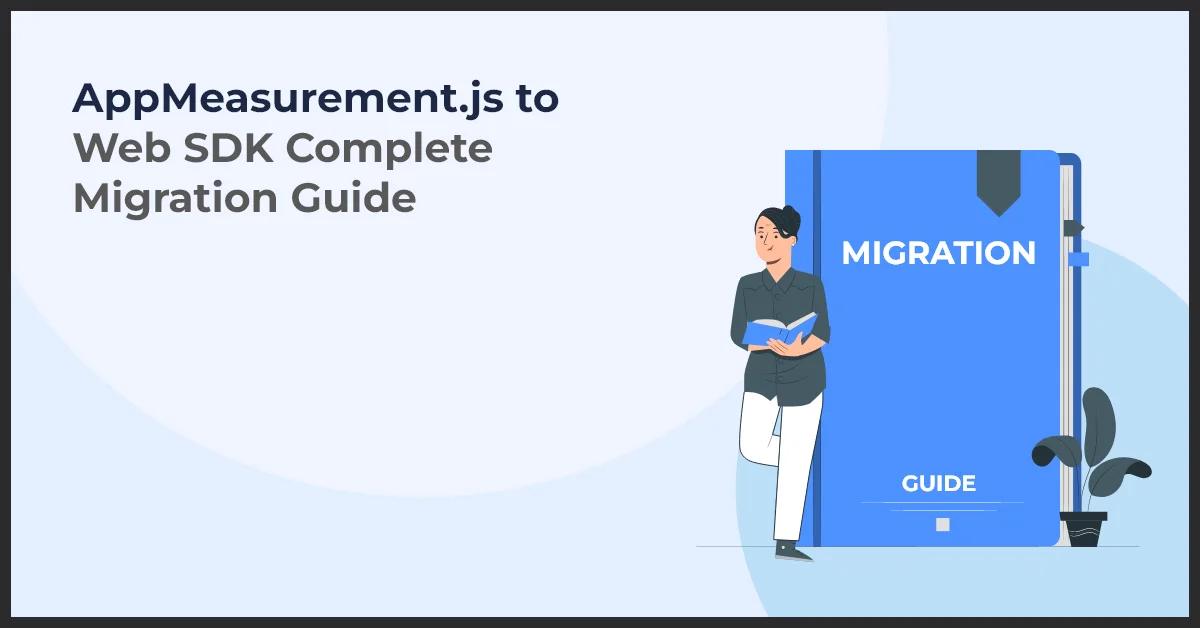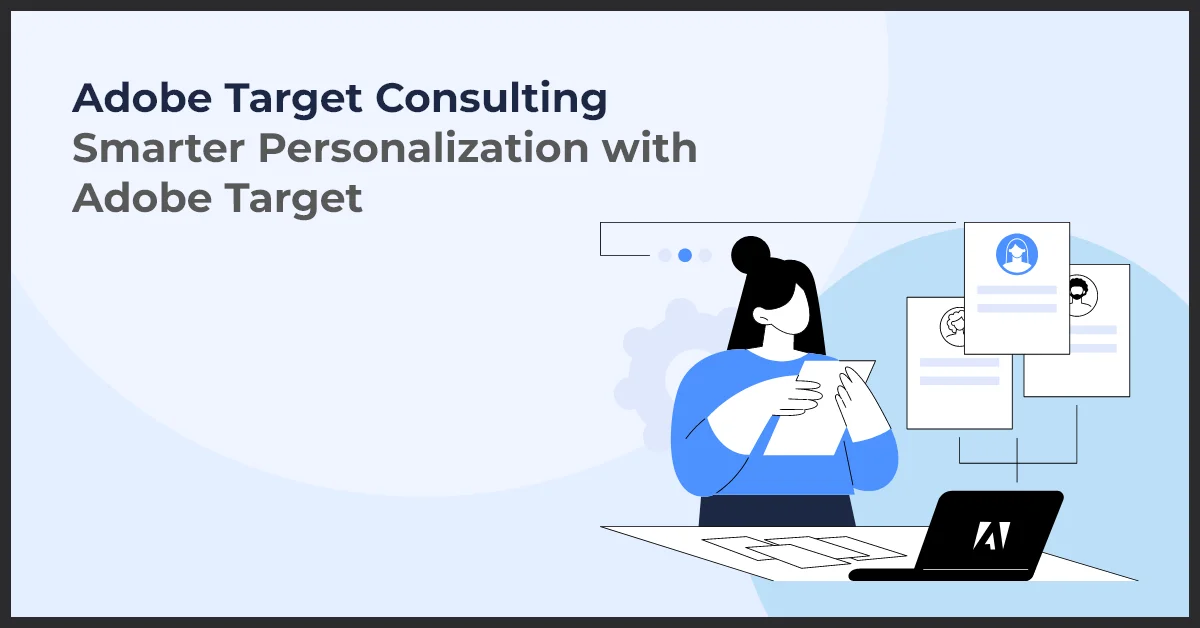Why Data Analytics Is Taking the Center Stage in Digital Marketing

Published on: March 7, 2022
Updated on: September 27, 2024
2732 Views
- Analytics
20 min read
In a tech-savvy business world, a brand needs to have deep knowledge of its customers and their expectations. Data analytics must sit at the core of your digital marketing campaign. It enables you to offer products that meet the aspirations of customers in a personalized manner.
66% of marketers believe that data-driven decisions are more effective than assumptions and gut instincts. However, the quality of data is important for making effective marketing decisions.
If the data is inaccurate or hasn’t been analyzed, it can lead to poor decisions and prevent you from reaching your business goals.
As the world moves toward Big Data and Artificial Intelligence, data analytics is gaining more significance in digital marketing. Though the spending on data analytics is high, it is justified by the ROI that analytics offer to digital marketers. Analytics help brands know their customers, thereby allowing them to identify ways to boost customer engagement. As a result, with the aid of analytics, you can integrate strategy and marketing with technology.
In this write-up, we shall look at data analytics and why it is taking the center stage in digital marketing today.
What Is Data Analytics?
Data analytics is a systematic computation/ transformation of raw data into meaningful information. In the past, data analytics was restricted to mathematicians and statisticians but the IT Revolution has made this a key element of business decision making.
With automation, data analysts can analyze and validate tons of data collected from various sources which would have been unimaginable in the past. Since data analytics tools compile data from multiple sources and offer a treasure trove of information, it is a core part of digital marketing campaigns today.
Data Analytics in Digital Marketing: Unleashing the Power of Data for Business Success
In the era of technology businesses thrive on data as it is the driver of success. Data analytics involves the process of collecting, analyzing and interpreting amounts of information to gain insights and make well informed decisions. In marketing data analytics plays a role as companies utilize data driven strategies to comprehend customer behavior, optimize marketing campaigns and achieve better outcomes.
The significance of data analytics in marketing cannot be overstated. It empowers businesses to delve into their target audiences preferences, requirements and online habits. By examining patterns in data companies can identify the marketing channels, enhance customer engagement and customize their campaigns to deliver personalized experiences. Additionally data analytics enables businesses to measure the effectiveness of their marketing initiatives. It highlights areas that need improvement while facilitating data backed decision making for maximizing return on investment.
The advantages that data analytics offers businesses are immense. By harnessing the power of data companies can make predictions about future market trends and gain a competitive edge over rivals. Data analytics also aids in pinpointing customer pain points which allows businesses to provide tailored solutions that improve customer satisfaction.
In addition businesses have the opportunity to enhance their marketing budgets by allocating resources to the channels and eliminating any inefficiencies. Ultimately data analytics serves as a tool for growth enabling businesses to make decisions and achieve remarkable success in the ever changing realm of digital marketing.
Understanding customer behavior is essential for any marketing strategy. By examining data businesses can gain insights into their customers preferences, interests and purchasing habits.
The significance of analyzing customer behavior lies in its ability to help marketers customize their strategies to meet the needs and preferences of their target audience. By understanding what drives customers to take action, businesses can optimize their marketing efforts. Increase conversions. Furthermore, analyzing customer behavior allows businesses to identify obstacles or challenges that may hinder customers from completing a purchase or engaging with their brand. By addressing these concerns businesses can enhance customer satisfaction and foster loyalty.
Several techniques are employed for customer behavior analysis. Web analytics involves measuring, collecting and analyzing data pertaining to website traffic and user behavior. It offers insights into how visitors interact with a website allowing businesses to optimize website design and content accordingly.
Social media analytics involves the monitoring and analysis of data, from social media platforms to gain insights into customer sentiment, engagement and preferences. It helps businesses identify trends and create targeted marketing campaigns.
Predictive analytics on the hand utilizes data and statistical algorithms to make predictions about future customer behavior. This enables businesses to anticipate customer needs, personalize marketing messages and optimize their marketing campaigns.
Customer analysis plays a role in marketing by offering several benefits
1. Improved targeting- By analyzing customer characteristics businesses can tailor their marketing messages to customer segments. This personalized approach increases the likelihood of converting customers into buyers.
2. Enhanced customer experience- Understanding customer preferences empowers businesses to provide a personalized experience for their customers. This does not increase satisfaction but fosters loyalty.
3. Informed decision-making- Customer analysis provides insights based on data-driven information. These insights enable businesses to make decisions regarding their marketing strategies, product development, and overall customer engagement.
4. Increased ROI- By leveraging the findings from customer analysis businesses can optimize their marketing efforts effectively. This optimization leads to a return on investment (ROI). Maximized revenue generation.
Campaign performance tracking is a part of any marketing strategy as it allows marketers to gauge the effectiveness of their campaigns accurately. By tracking metrics identifying areas for improvement becomes possible which in turn enables marketers to optimize their efforts, for results.
By utilizing data analysis marketers can obtain insights into the performance of their campaigns. Make data-informed decisions to improve their marketing efforts.
Importance of Tracking Campaign Performance
The tracking of campaign performance allows marketers to effectively monitor and evaluate the success of their marketing campaigns. It enables them to assess how well their campaigns are performing and whether they are meeting their goals. Through performance tracking marketers can identify what strategies are effective and what areas need improvement enabling them to make decisions regarding resource allocation.
Key Metrics for Performance Tracking
There are metrics that play a crucial role in monitoring and optimizing campaign performance;
1. Conversion Rate: The conversion rate measures the percentage of website visitors who take a desired action such as making a purchase or filling out a form. Tracking conversion rates helps marketers gauge the effectiveness of their campaigns in driving desired actions.
2. Click-Through Rate (CTR): The click-through rate measures the percentage of individuals who click on a link or advertisement. Monitoring CTR helps marketers evaluate audience interest and engagement levels.
3. Cost per Acquisition (CPA): The cost per acquisition reflects how much it costs to acquire a customer. By tracking CPA marketers can evaluate the efficiency of budget allocation within their campaigns.
Return on Investment (ROI): ROI measures the profitability of a marketing campaign, by comparing the revenue generated to the cost incurred. It assists marketers in assessing the success of their campaigns and making decisions for investments.
The Role of Data Analytics in Improving Campaign Performance Tracking
Data analytics plays a role in enhancing campaign performance tracking. It empowers marketers to gather, analyze, and interpret data for insights into their campaigns. By leveraging data analytics marketers can;
- Identify patterns and trends in campaign performance data.
- Target audience groups to achieve better campaign results.
- Optimize marketing channels based on data-driven insights.
- Make decisions backed by data to improve campaign performance.
Techniques for Optimizing Campaigns Using Data Analytics
Data analytics equips marketers with techniques to optimize their campaigns
Conducting A/B testing to compare versions of a campaign and determine the most effective one.
Segmenting audience groups based on their behavior and preferences to deliver personalized campaigns.
Utilizing predictive modeling to forecast campaign performance and make informed decisions.
Employing data visualization techniques to present campaign performance data clearly and comprehensively.
The Significance of A/B Testing, in Making Data-Informed Decisions
A/B testing holds importance within the realm of marketing's data analytics domain. Marketers can utilize A/B testing to compare two versions of a webpage or marketing campaign and analyze their performance. By extracting insights, from this process, marketers can make decisions that optimize their marketing strategies based on data-driven analysis.
Why A/B Testing is Important, in Digital Marketing
A/B testing holds significance as it allows marketers to pinpoint the effective elements within their campaigns. By experimenting with variations like headlines, call to action buttons or color schemes marketers can identify which options yield response rates and conversions. This valuable insight empowers them to optimize their marketing strategies for outcomes.
The Role of A/B Testing in Data Driven Decision Making
Through A/B testing marketers can gather data that drives their decision-making process. By relying on assumptions or guesswork A/B testing enables them to base decisions on user behavior and preferences. This data-driven approach significantly enhances the likelihood of success while minimizing the risk of errors.
Steps for Conducting A/B Testing in Marketing Campaigns
Step 1. Define the objective; Begin by establishing a goal for your A/B test. This could involve increasing through rates enhancing conversions or reducing bounce rates.
Step 2. Develop two versions; Create two variations of your webpage, email or advertisement. These versions should primarily differ in one aspect, like the headline or design.
Step 3. Divide your target audience into two groups randomly. Show each group one of the two variations making sure you can accurately measure and compare their performance.
Step 4. Use analytics tools to track the performance of each version. Collect data on metrics like click-through rates, conversions, or engagement levels.
Step 5. Compare the performance of each variant by analyzing the collected data. Determine which version performed better and align it with your objective.
Step 6. Based on the results of the A/B test implement the winning variant as the default option for your marketing campaign.
Examples of Successful A/B Testing Scenarios
Test colors for call-to-action buttons to find out which one generates clicks.
Compare two versions of a landing page to see which one leads to conversion rates.
Experiment with subject lines in email campaigns to identify the compelling option.
Big Data Analysis for Marketing Strategies
In today's world businesses are increasingly relying on data to shape their marketing strategies. With access to amounts of data, big data analysis has become a tool for marketers.
Definition and Overview of Big Data Analysis
Big data analysis refers to extracting insights and patterns from datasets. It involves analyzing and interpreting data to uncover trends, behaviors and customer preferences that can shape marketing strategies.
With the rise of media, mobile devices and the Internet of Things (IoT) the amount of data has grown exponentially. This abundance of data has opened up opportunities for marketers to make decisions through big data analysis.
Big data plays a role in marketing by providing marketers with a deeper understanding of their target audience. It allows them to uncover customer trends, preferences and buying patterns enabling targeted marketing campaigns.
By analyzing data marketers can segment their audience. Create customer profiles based on demographics, behaviors and interests. This valuable information can then be used to customize marketing messages and offers for customer segments resulting in conversion rates.
In marketing there are techniques and tools available for analyzing big data. These include data mining, which involves extracting patterns and knowledge from datasets using algorithms and statistical models. Machine learning algorithms can also be utilized to analyze data in order to identify patterns, make predictions and automate marketing processes. Additionally text mining techniques can be employed to analyze data like customer reviews or social media posts to gain insights and extract sentiment.
Overall big data analysis empowers marketers by providing them with insights that enhance their understanding of customers needs and preferences, in the landscape. Predictive analytics involves utilizing data to predict trends and customer behavior enabling marketers to make well informed decisions.
Role of Big Data in Digital Marketing
Data plays a role in digital marketing as it provides marketers with a deeper understanding of their target audience. It empowers them to identify customer trends, preferences and buying patterns with precision. This knowledge allows for targeted marketing campaigns that resonate with customers on a more individual level.
Importance of A/B Testing in Digital Marketing
A/B testing holds importance in marketing as it enables marketers to identify the most impactful elements within their campaigns. By testing variations such as headlines, call to action buttons or color schemes marketers can gain insights into which variants generate response rates or conversions. Armed with this information they can fine tune their marketing campaigns, for results.
Real life Instances of Successful Big Data Analysis, in Marketing
companies have already harnessed the potential of data analysis to drive successful marketing campaigns. For instance;
- Netflix - By examining customer data Netflix can suggest personalized content for each user resulting in increased engagement and customer satisfaction.
- Amazon - Amazon employs data analysis to offer customers personalized product recommendations based on their browsing and purchase history.
- Starbucks - Through their app Starbucks gathers data on customer preferences and behavior to provide tailored promotions and rewards.
These examples exemplify how big data analysis holds the capability to shape marketing strategies while delivering customized experiences for customers.
Marketing Automation and Data Analytics
Understanding Marketing Automation
Marketing automation refers to the utilization of software and technology to automate marketing tasks. It enables businesses to streamline their marketing efforts by automating processes like email campaigns, social media posting lead nurturing, among others.
Benefits of Combining Marketing Automation, with Data Analytics
When marketing automation is combined with data analytics businesses can gain insights that help optimize their marketing strategies.
By examining information from sources, like website analytics, customer behavior and campaign performance marketers can use data to make decisions and tailor their marketing efforts.
There are advantages to combining marketing automation with data analytics
Improved targeting - By analyzing customer data businesses can create precise and personalized marketing campaigns that lead to higher conversion rates.
Enhanced lead nurturing - Data analytics can help identify the leads enabling businesses to automate relevant and timely follow ups in order to nurture those leads effectively.
Optimized customer journey - By analyzing customer behavior, across touchpoints businesses can automate interactions that guide customers through the sales funnel.
Increased efficiency - Marketers can save time. Increase productivity by automating tasks allowing them to focus on more strategic activities.
Use Cases, for Marketing Automation and Data Analytics
There are scenarios where combining marketing automation with data analytics can greatly contribute to the success of digital marketing strategies:
Lead scoring and segmentation - By analyzing customer data businesses have the ability to assign scores to leads based on their behavior and characteristics. This enables segmentation and targeted messaging.
Email marketing - Through the analysis of rates click through rates and conversion rates marketers can automate email campaigns that ensure the right message reaches the right audience at the most opportune time.
Social media marketing - By examining social media data businesses have the opportunity to automate social media postings and targeted advertisements based on user demographics, interests and behavior.
Personalization across channels - By integrating data from sources like website analytics and CRM systems businesses can automate personalized experiences across channels including websites, emails and mobile applications.
The Importance of ROI Measurement in Data Analytics
One of the aspects of utilizing data analytics in marketing is measuring return on investment (ROI). Businesses are focused on understanding both the effectiveness and profitability of their marketing efforts. ROI measurement provides them with a means to assess the success of their campaigns.
The Significance of ROI Measurement in Digital Marketing
ROI measurement plays a role, in determining the value generated by each marketing initiative. Businesses rely on questions to guide their decision making, such as:
Are our marketing efforts producing revenue?
Which campaigns or channels are delivering the return on investment (ROI)?
How can we optimize our marketing budget by making necessary adjustments?
To accurately measure ROI, specific techniques need to be implemented. Some used techniques include:
- Tracking codes- By utilizing tracking codes businesses can monitor where their website visitors come from and attribute conversions to marketing efforts.
- Conversion goals - Defining conversion goals enables businesses to assess the success of their marketing campaigns based on user actions like form submissions or product purchases.
- UTM parameters - These tags added to URLs help identify the source, medium and campaign associated with each website visit allowing for ROI measurement.
By employing these techniques businesses can gather data. Analyze the monetary return generated by their marketing activities.
The role of data analytics is crucial in facilitating ROI measurement, within marketing strategies.Using data analytics tools businesses can take advantage of the following benefits:
- Tracking and capturing data - Data analytics tools allow businesses to gather and analyze data from sources, including website analytics, social media platforms and email marketing.
- Obtaining insights - By examining the collected data businesses can gain insights into their marketing performance, identify areas for improvement and make informed decisions based on data to maximize their return on investment (ROI).
- Measuring the impact of marketing campaigns - Data analytics tools enable businesses to assess the effectiveness of their marketing campaigns by analyzing metrics such as conversions, click through rates and customer acquisition costs. This analysis ultimately facilitates the calculation of ROI.
By utilizing the power of data analytics businesses can develop an understanding of their marketing ROI. Continuously refine their strategies to achieve better outcomes.
How Data Analytics Can Strengthen Your Digital Marketing Strategy
Data analytics helps you zero in on trends, opportunities, and risks that you are likely to miss otherwise. With it, your marketing team gets actionable insights when running marketing campaigns.
A marketing campaign sans analytics is synonymous with shooting in the dark. Irrespective of the size and scale of your digital campaigns, your brand can use data analytics in some form to power your marketing strategy. Here are some of the ways you can utilize analytics:
1. Make Data-Driven Decisions
The success of any digital marketing campaign rests on your knowledge of the market. When your marketing team analyzes customer data, you can easily spot trends and opportunities, thus making data-driven decisions. Raw data by itself doesn’t offer meaningful insights to digital marketers. In fact, in many cases, raw data can be misleading and lead to wrong decisions. Therefore, you must analyze it in depth, including studying the KPIs that help brands in effective decision-making.
2. Leverage Customer Insights
Brands that know the pulse of the market stay ahead in the race. If we have to pick the most important incentive of data analytics in digital marketing, this would outrank others. Analytics lets you get inside the hearts and brains of your customer.
You need to know who your customers are and where they are coming from. You must have a strong idea about the aspirations they have. You can identify target groups within your customer base and build different personas for your marketing campaign.
3. Personalize Your Campaigns
In the present world, marketing personalization is increasingly becoming vital for transforming the customer experience. Your customers have varied needs and they want to be treated in a personalized manner.
Data analytics can help you understand the behavior of your customers, their needs, and buying habits. Therefore, you can personalize your marketing campaigns with targeted ads, personalized emails, notifications, and offers. As a result, build the perfect DXPs (digital experience platforms).
4. Market Through the Right Channels
Digital marketing is a diverse field and brands use different channels to engage their target audience. Here, the choice of the right marketing channels is important for the success of your campaign.
Though your brand would be running campaigns on multiple channels, it is important to identify channels that are likely to ensure increased engagement and higher conversions. For instance, if you are a B2B business, Twitter and LinkedIn may lead to more engagement compared to Instagram. However, Instagram is more ideal for brands targeting youths and Gen Z than the other two channels.
5. Ensure Targeted Content Marketing
‘Content is King’ in digital marketing, and the most important element for all messaging and communication. Publishing blogs and creating landing pages won’t earn you the dividends until this is backed by a solid and informed marketing strategy.
Data analytics helps businesses pursue the right content marketing strategy. Analytics helps marketers know what the audience is searching for, keywords they are using, and the kind of content they engage with. All this information helps brands in choosing the right content marketing strategy. Data analytics can help identify keywords your competitors are using to rank high on SERP and outbid them for paid search marketing.
6. Leverage Predictive Analysis
Predictive analytics is vital for the success of any business. Digital marketers are leveraging this technique to predict opportunities and risks for their campaigns. With this data analytics technique, marketers can gauge the future mood of the market and the likely moves of customers.
Using predictive analytics, you can foresee the emerging trends in the industry, do traffic and sales forecasts, and gain other important insights that help target the right audience at the right time. As a result, you can keep your business ahead of the competition.
7. Boost Conversational Marketing
Conversational marketing is gaining currency. More than 70% of customers expect brands to respond to them in real time. Businesses are deploying AI-powered chatbots, live chats, and social media platforms as primary tools to keep their audience engaged. Data analytics trains chatbots to respond to queries appropriately based on intelligence gathered from earlier conversations.
8. Gain Competitive intelligence
In today’s competitive world, it is a must for every brand to stay invested in the marketing strategy of their competitors. Competitive intelligence helps your business stay ahead of the competition. This is aimed at gathering and analyzing data about your competitors, the larger industry, and the overall business environment.
Data Analytics plays a key role here as it offers your marketers deeper insights into your competitors and the market. Using competitor intelligence tools, you can analyze competitors’ data such as price changes, customer feedback, reviews, marketing campaigns, and much more. The better you know about your competitors, the easier it gets to outperform them.
Final Thoughts
To sum up, data analytics is the key driver for a successful digital marketing campaign. It ensures your campaigns are targeted and your business goals are being met. With deeper insights about your customers and their aspirations, your brand would be able to engage them actively and earn their loyalty. Your brand must focus on a data-driven digital marketing strategy that is aligned with your business goals and addresses the niche needs of your target audience. If you are looking for a data-driven digital marketing campaign, Growth Natives can help. We have marketers with years of experience in diverse fields of digital marketing. Data analytics sits at the heart of our marketing campaigns. We spot the emerging trends in the market to help your brand stay ahead of the competition. To get started with your digital marketing campaign, write to us at info@growthnatives.com or visit our website.
Frequently Asked Questions
The five types of data analytics are descriptive analytics, diagnostic analytics, predictive analytics, prescriptive analytics, and exploratory analytics.
The role of data analytics is to analyze and interpret data to gain insights, make informed decisions, and drive business strategies.
The four pillars of data analytics are data collection, processing, analysis, and visualization.



